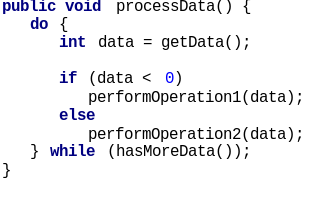Related Research Articles

A quine is a computer program which takes no input and produces a copy of its own source code as its only output. The standard terms for these programs in the computability theory and computer science literature are "self-replicating programs", "self-reproducing programs", and "self-copying programs".
In computing, the Java Remote Method Invocation is a Java API that performs remote method invocation, the object-oriented equivalent of remote procedure calls (RPC), with support for direct transfer of serialized Java classes and distributed garbage-collection.
In software engineering, the mediator pattern defines an object that encapsulates how a set of objects interact. This pattern is considered to be a behavioral pattern due to the way it can alter the program's running behavior.
In software design and engineering, the observer pattern is a software design pattern in which an object, named the subject, maintains a list of its dependents, called observers, and notifies them automatically of any state changes, usually by calling one of their methods.

The syntax of Java is the set of rules defining how a Java program is written and interpreted.

In software engineering, dependency injection is a programming technique in which an object or function receives other objects or functions that it requires, as opposed to creating them internally. Dependency injection aims to separate the concerns of constructing objects and using them, leading to loosely coupled programs. The pattern ensures that an object or function which wants to use a given service should not have to know how to construct those services. Instead, the receiving 'client' is provided with its dependencies by external code, which it is not aware of. Dependency injection makes implicit dependencies explicit and helps solve the following problems:
In computer programming, an entry point is the place in a program where the execution of a program begins, and where the program has access to command line arguments.
In mathematics and in computer programming, a variadic function is a function of indefinite arity, i.e., one which accepts a variable number of arguments. Support for variadic functions differs widely among programming languages.
In the Java programming language, the final keyword is used in several contexts to define an entity that can only be assigned once.
In number theory, a narcissistic number in a given number base is a number that is the sum of its own digits each raised to the power of the number of digits.
In the Java computer programming language, an annotation is a form of syntactic metadata that can be added to Java source code. Classes, methods, variables, parameters and Java packages may be annotated. Like Javadoc tags, Java annotations can be read from source files. Unlike Javadoc tags, Java annotations can also be embedded in and read from Java class files generated by the Java compiler. This allows annotations to be retained by the Java virtual machine at run-time and read via reflection. It is possible to create meta-annotations out of the existing ones in Java.
In computer programming, an anonymous function is a function definition that is not bound to an identifier. Anonymous functions are often arguments being passed to higher-order functions or used for constructing the result of a higher-order function that needs to return a function. If the function is only used once, or a limited number of times, an anonymous function may be syntactically lighter than using a named function. Anonymous functions are ubiquitous in functional programming languages and other languages with first-class functions, where they fulfil the same role for the function type as literals do for other data types.
Generics are a facility of generic programming that were added to the Java programming language in 2004 within version J2SE 5.0. They were designed to extend Java's type system to allow "a type or method to operate on objects of various types while providing compile-time type safety". The aspect compile-time type safety was not fully achieved, since it was shown in 2016 that it is not guaranteed in all cases.
In computer programming, a local variable that is assigned a value but is not read by any subsequent instruction is referred to as a dead store. Dead stores waste processor time and memory, and may be detected through the use of static program analysis, and removed by an optimizing compiler.
In the Java programming language, the constant interface pattern describes the use of an interface solely to define constants, and having classes implement that interface in order to achieve convenient syntactic access to those constants. However, since constants are very often merely an implementation detail, and the interfaces implemented by a class are part of its exported API, this practice amounts to putting implementations details into the API, which was considered inappropriate by, e.g., Java designer Joshua Bloch. In general, collecting system constants into classes independent of behaviour might create a poor object-oriented design because it is often a sign of low cohesion. For these reasons, constant interfaces may be considered an anti-pattern.
Different command-line argument parsing methods are used by different programming languages to parse command-line arguments.
Ateji PX is an object-oriented programming language extension for Java. It is intended to facilliate parallel computing on multi-core processors, GPU, Grid and Cloud.
In software engineering, the module pattern is a design pattern used to implement the concept of software modules, defined by modular programming, in a programming language with incomplete direct support for the concept.
Castor is a data binding framework for Java with some features like Java to Java-to-XML binding, Java-to-SQL persistence, paths between Java objects, XML documents, relational tables, etc. Castor is one of the oldest data binding projects.
Apache Commons Logging is a Java-based logging utility and a programming model for logging and for other toolkits. It provides APIs, log implementations, and wrapper implementations over some other tools.